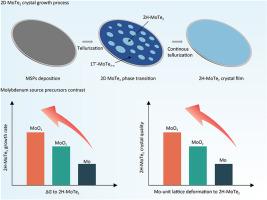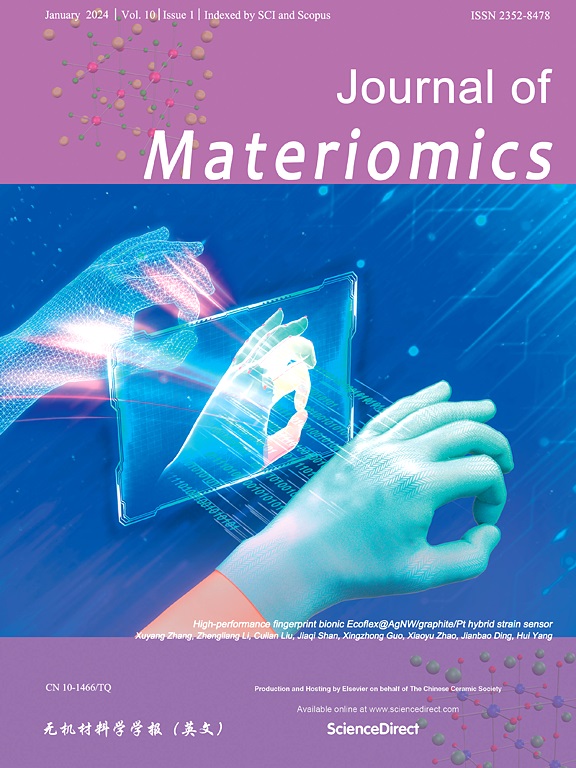Controlled lattice deformation for high-mobility two-dimensional MoTe2 growth
IF 8.4
1区 材料科学
Q1 CHEMISTRY, PHYSICAL
引用次数: 0
Abstract
Two-dimensional (2D) MoTe2 shows great potential for future semiconductor devices, but the lab-to-fab transition is still in its preliminary stage due to the constraints in the crystal growth level. Currently, the chemical vapor deposition growth of 2D MoTe2 primarily relies on the tellurization process of Mo-source precursor (MSP). However, the target product 2H-MoTe2 from Mo precursor suffers from long growth time and suboptimal crystal quality, and MoOx precursor confronts the dilemma of unclear growth mechanism and inconsistent growth products. Here, we developed magnetron-sputtered MoO3 film for fast and high-mobility 2H-MoTe2 growth. The solid-to-solid phase transition growth mechanism of 2D MoTe2 from Mo and MoOx precursor was first experimentally unified, and the effect mechanism of MSPs on 2D MoTe2 growth was systematically elucidated. Compared with Mo and MoO2, the MoO3 precursor has the least Mo-unit lattice deformation and exhibits the optimal crystal quality of growth products. Meanwhile, the lowest Gibbs free energy change of the chemical reaction results in an impressive 2H-MoTe2 growth rate of 8.07 μm/min. The constructed 2H-MoTe2 field-effect transistor array from MoO3 precursor showcases record-high hole mobility of 85 cm2·V-1·s-1, competitive on-off ratio of 3×104, and outstanding uniformity. This scalable method not only offers efficiency but also aligns with industry standards, making it a promising guideline for diverse 2D material preparation towards real-world applications.

控制晶格变形,促进高迁移率二维碲化镉(MoTe2)生长
二维(2D)MoTe2 在未来半导体器件中显示出巨大潜力,但由于晶体生长水平的限制,实验室到实验室的过渡仍处于初级阶段。目前,二维 MoTe2 的化学气相沉积生长主要依赖于钼源前驱体(MSP)的碲化过程。然而,Mo 前驱体的目标产物 2H-MoTe2 存在生长时间长、晶体质量不理想等问题,而 MoOx 前驱体则面临生长机制不明确、生长产物不一致的困境。在此,我们开发了磁控溅射 MoO3 薄膜,用于 2H-MoTe2 的快速、高流动性生长。实验首次统一了Mo和MoOx前驱体的二维MoTe2固-固相变生长机制,并系统地阐明了MSP对二维MoTe2生长的影响机制。与 Mo 和 MoO2 相比,MoO3 前驱体的 Mo 单位晶格变形最小,生长产物的晶体质量最优。同时,由于化学反应的吉布斯自由能变化最小,2H-MoTe2 的生长速率达到了惊人的 8.07 μm/min。利用 MoO3 前驱体构建的 2H-MoTe2 场效应晶体管阵列具有 85 cm2-V-1-s-1 的创纪录高空穴迁移率、3×104 的竞争性导通比和出色的均匀性。这种可扩展的方法不仅效率高,而且符合行业标准,是制备各种二维材料、实现实际应用的可行指南。
本文章由计算机程序翻译,如有差异,请以英文原文为准。
求助全文
约1分钟内获得全文
求助全文
来源期刊

Journal of Materiomics
Materials Science-Metals and Alloys
CiteScore
14.30
自引率
6.40%
发文量
331
审稿时长
37 days
期刊介绍:
The Journal of Materiomics is a peer-reviewed open-access journal that aims to serve as a forum for the continuous dissemination of research within the field of materials science. It particularly emphasizes systematic studies on the relationships between composition, processing, structure, property, and performance of advanced materials. The journal is supported by the Chinese Ceramic Society and is indexed in SCIE and Scopus. It is commonly referred to as J Materiomics.
 求助内容:
求助内容: 应助结果提醒方式:
应助结果提醒方式:


